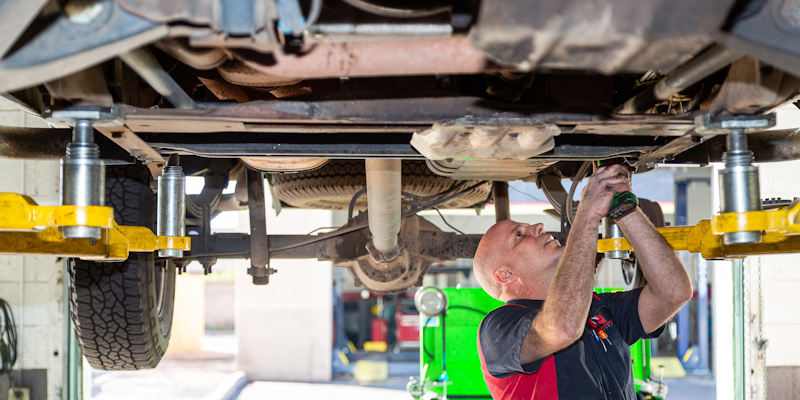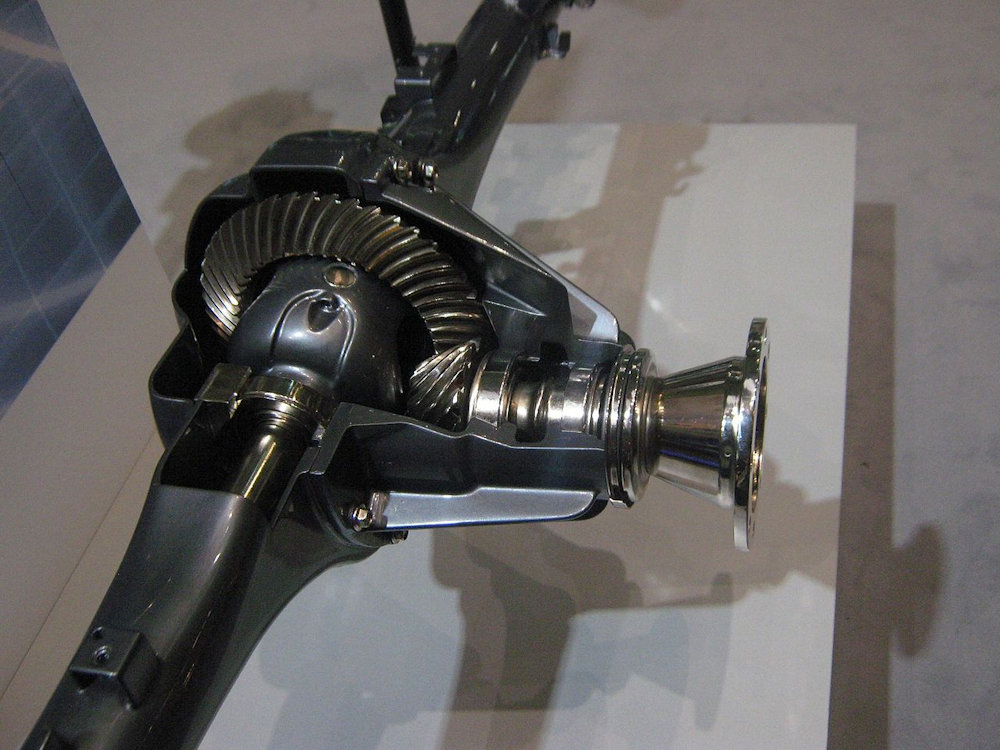
Crawford’s Auto Repair offers drivetrain repairs, including differential repairs for vehicle owners in Chandler, Gilbert and nearby municipalities.
Schedule An AppointmentIf your vehicle is having intense vibrations or turning problems then you may need drivetrain services or differential repair. Bring it to Crawford's Auto Repair today. Call 480-201-0740 to schedule an appointment.
The drivetrain transfers kinetic energy from the engine to the wheels. It’s essentially the cart portion of the “horseless carriage”. It is able to transfer the kinetic energy from the engine to the wheels through a series of gears and shafts.
The major parts of the drivetrain are the transmission, drive shaft, differential and axles. The transmission and differential are “boxes of gears” that provide mechanical advantage and a change in the direction of kinetic energy. The transmission is the first to receive kinetic energy from the crankshaft of the engine. It uses gears to provide mechanical advantage for when the driver wants the vehicle to go fast, slow, on flat surfaces or on hills. Each situation calls for a change between the available gears, or simply “changing gears”.
In order to understand how gears can provide a mechanical advantage it may help some individuals to visualize the different gears of a bicycle. A multi-geared bicycle may have cogs of different sizes at the pedals and cogs of different sizes at the center of the rear wheel. When the rider pedals on a flat surface they pedal in higher gears to go faster. When they are pedaling uphill, they pedal in lower gears so that it’s not as hard to pedal. As the rider switches gears the chain moves between different cogs. The gear ratios change the output of the pedaling. This is the mechanical advantage that gears provide in each situation and it’s even more sophisticated in motor vehicles.

A Differential Cutout Showing Gears (CC BY-SA 2.0 Norbert Schnitzler)
The transmission then transfers the adjusted kinetic energy down the drive shaft to the differential (in a rear-wheel drive vehicle). Since the wheel axles and the drive shaft form a “T” shape, the kinetic energy has to be transferred across 90 degree angles when driving in a straight line and varying degree angles when the vehicle is turning corners, since the inner wheel won’t turn as much as the outer wheel has to. The gears in the differential allow the rear wheels to turn at different rates when turning corners.
In order to visualize how gears can transfer the direction of kinetic energy, imagine two gears with their cogs intertwining at a 90 degree angle instead of being on the same plane, or look at the differential pictured with a cutout to expose the gears.
These are the the most basic parts. Certain types of vehicles may have other “gear box” parts such as a clutch (commonly referred to in manual transmission vehicles) or a transfer case in 4-wheel drive vehicles. Beyond the transfer case a 4-wheel drive vehicle could have a rear and front differential. In an all-wheel drive vehicle there could be a front, central and rear differential. A transaxle is found in front wheel drive vehicles which is a transmission and differential combined. The drivetrain will have a specific arrangement for each of the following types of vehicles:
- Rear Wheel Drive (RWD)
- Front Wheel Drive (FWD)
- 4-Wheel Drive (4WD)
- All Wheel Drive (AWD)
A separate page is devoted to Transmission Services. Also learn more about 4WD and AWD Vehicle Services. This page focuses on the differential, drive shaft, axles, U-joints, CV-joints and other small parts of the drivetrain.
Drivetrain & Differential Maintenance
The most commonly discussed drivetrain maintenance involves the transmission, although the rest of the drivetrain should still be monitored and repaired as needed.
The differential and rest of the drivetrain are often inspected with standard maintenance checks. This involves a visual inspection of the parts with the vehicle raised on hydraulic lifts.
The differential fluid may also be checked if it has an accessible port and we will suggest further investigation if the fluid is low or dirty. Otherwise you may be due for differential maintenance service every 30,000 to 60,000 miles depending on manufacturer’s specifications. The owner’s manual is referenced for the exact mileage. Learn more about vehicle fluids maintenance.
During the standard maintenance checks we test drive the vehicle, during which the technician would notice signs potentially related to the differential and drivetrain.
If your universal joints are the type that can be lubricated then they should be re-lubricated with each oil change. The CV joints are only re-greased when they are replaced or when the boot that contains them is broken.
DIY Maintenance Tips For The Driver:
- Do not “ride” the clutch if you have a manual transmission.
- For front-wheel drive vehicles avoid applying the gas while the wheels are turned at full lock to protect universal joints.
Signs of A Failing Differential Or Other Drivetrain Parts
Visible signs of damage or fluid leaks from the differential or other parts of the drivetrain will merit further inspection and repair.
If you have any vibrations or shuddering while driving at a constant speed, high speeds, accelerating, decelerating or turning then be sure to note the specific circumstances when it occurs. This will be helpful during the initial evaluation.
A strong burning oil smell can also be present with a failing differential and other failing drivetrain parts.
Differential Repair And Other Drivetrain Repairs
Repairs for a differential in a rear-wheel drive or even four-wheel drive vehicles are much more accessible than in front-wheel drive vehicles which have a transaxle. In any drivetrain composition, there are some differentials that can be repaired with a differential rebuild. Others will require a differential replacement.
The following is a more complete list of possible differential and other drivetrain repairs, excluding repairs directly related to the transmission or 4WD and AWD vehicles, which are devoted to different pages.
- CV Axle/shaft assembly replacement
- Axle shaft seal replacement
- Differential gasket replacement
- Differential output seal replacement
- Speed sensor replacement
- Speedometer cable repair
- Speedometer cable and housing replacement
- Transfer case fluid replacement
- Universal joint lubrication
- Differential Rebuild
- Differential Replacement
- Differential Repair
- Differential fluid replacement (differential fluid service)
- Drivetrain repair
- Drive shaft lubrication
- Universal joint lubrication (U-joint lubrication)
- Universal joint replacement (U-joint replacement)
Call 480-201-0740 To Schedule Differential Repair Or Other Drivetrain Services Today
If your vehicle is vibrating while driving or if the differential is due for servicing then bring your vehicle to the shop today. An expert technician will evaluate your vehicle, give you a straightforward presentation of the findings and discuss the best options for repairs with you. We don’t pay staff by commissions and we never try to sell unnecessary repairs. Call 480-201-0740 to schedule an appointment today.


No Comments
Sorry, the comment form is closed at this time.